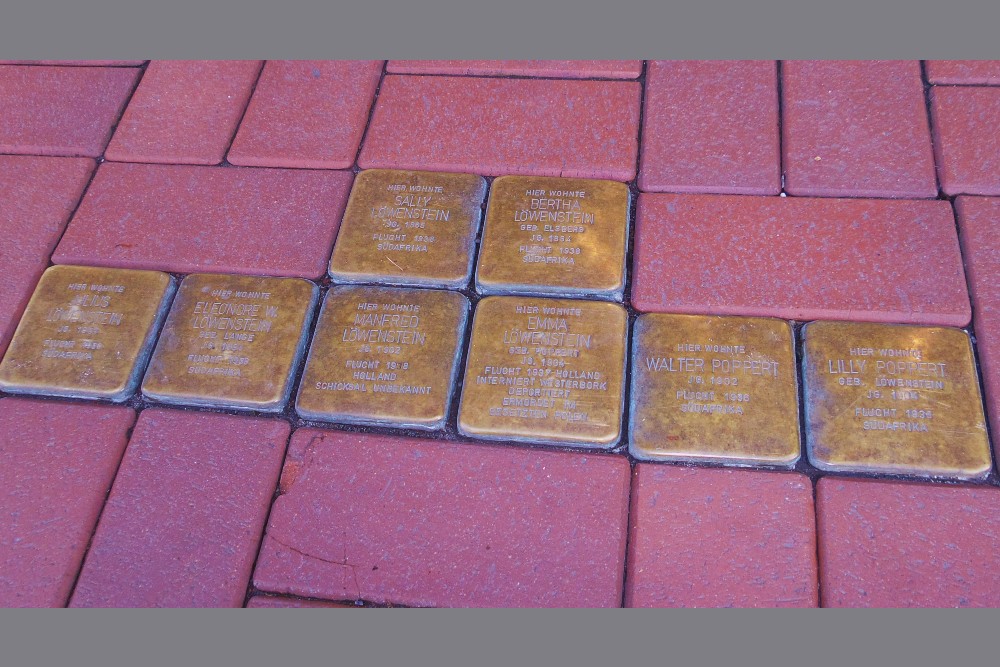Stumbling Stones Unterer Markt 2
These small, brass, memorial plaques (Stolpersteine or stumbling stones) commemorate:
* Sally Löwenstein, born 1865, fled 1938 to South Africa.
* Bertha Löwenstein née Elsberg, born 1864, fled 1938 to South Africa.
* Julius Löwenstein, born 1901, fled 1939 to South Africa.
* Eleonore W. Löwenstein née Lange, born 1898, fled 1939 to South Africa.
* Manfred Löwenstein, born 1902, fled 1938 to Holland, fate unknown.
* Emma Löwenstein née Poppert, born 1904, fled 1937 to Holland, interned at Westerbork, deported, murdered in occupied Poland.
* Walter Poppert, born 1902, fled 1936 to South Africa.
* Lilly Poppert nee Löwenstein, born 1904, fled 1936 to South Africa.
Sally and Bertha Löwenstein had three children: Julius (who married Eleonore Lange), Manfred (married Emma Poppert) and Lilly (married Walter Poppert, who may be Emma’s brother). Of the four couples remembered here, the three couples who fled to South Africa in 1936, 1938 and 1939 survived; the couple who fled to the Netherlands -- Manfred and Emma Löwenstein -- apparently did not.
Sally Löwenstein had a department store, which went bankrupt in 1928. Later, son Manfred opened another department store at Unterer Markt 2. A local anti-Jewish boycott in 1935 led to Manfred’s giving up the business. He rented the business to an SA (Sturmabteilung = Nazi paramilitary) man who did not pay. After very publicly calling the SA man a scoundrel and a cheater, Manfred and his wife Emma fled to the Netherlands. Records are unclear: one says Manfred went first to Nordhorn, Germany and then later to Amersfoort, NL, and Emma went to Enschede, NL (36 km from Nordhorn). She was murdered in Poland; his fate is unknown.
"Stolpersteine" is an art project for Europe by Gunter Demnig to commemorate victims of National Socialism (Nazism). Stolpersteine (stumbling stones) are small, 10x10cm brass plaques placed in the pavement in front of the last voluntary residence of (mostly Jewish) victims who were murdered by the Nazis. Each plaque is engraved with the victim’s name, date of birth, and place (mostly a concentration camp) and date of death. By doing this, Gunter Demnig gives an individual memorial to each victim. One stone, one name, one person. He cites the Talmud: "A human being is forgotten only when his or her name is forgotten."
Do you have more information about this location? Inform us!
Source
- Text: Fedor de Vries & Anne Palmer
- Photos: Jens-Erik Janke
- Stadt Museum Ibbenbüren, Stadtgeschichte
- Haus der Familie Löwenstein Unterer Markt 2
- Stolpersteine.eu
Nearby
Monument
- Franco-Prussian War Memorial Ibbenbüren - Ibbenbüren
- War Memorial Schierloh - Schierloh (Ibbenbüren)
- War Memorial Dörenthe - Dörenthe (Ibbenbüren)
Cemetery
- German War Graves Ibbenbüren - Ibbenbüren
- Mass Grave Soviet Prisoners of War Ibbenbüren - Ibbenbüren
- German War Cemetery Brumleytal - Birgte





